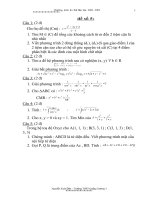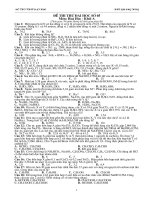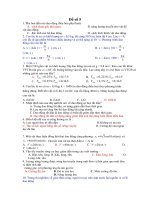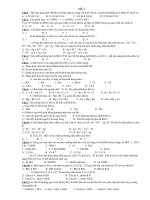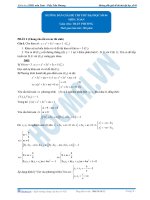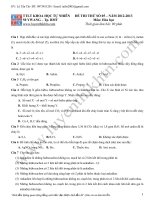ĐỀ THI THỬ số 5 2019
Bạn đang xem bản rút gọn của tài liệu. Xem và tải ngay bản đầy đủ của tài liệu tại đây (351.79 KB, 10 trang )
BIÊN SOẠN: ĐỖ HUYỀN TRANG
ĐỀ THI THỬ SỐ 5
Mark the letter A, B, C or D on your answer sheet to indicate the word
whose underlined part differs from the other three in pronunciation in
each of the following questions.
1. ( A) provision
2. ( A) none
( B) conclusion
( B ) zone
( C) pension
( C ) phone
( D ) precision
( D ) bone
Mark the letter A, B, C or D on your answer sheet to indicate the word
that differs from the other three in the position of primary stress in each
of the following questions.
3. ( A) domestic
4. ( A ) eminent
( B) dormitory
( B) elaborate
( C) dogmatic
( C) eloquent
( D ) deliberate
( D ) element
Mark the letter A, B, C or D on your answer sheet to indicate the
underlined part that needs correction in each of the following questions.
5. The warming of the Earth, which is primarily caused by the accumulation
of gases, are known as the greenhouse effect.
( A) warming
( B ) caused ( C ) are
( D ) the
6. I’ve got my photos drying out on the kitchen floor, so whatever you will
do, don’t tread on them!
( A) drying
( B) so
( C) will do
( D ) on
7. There is a rumour that the army is about taking power, though this has
been denied by government sources.
( A ) there
( B ) taking ( C) though
( D ) denied
Mark the letter A, B, C or D on your answer sheet to indicate the
correct answer to each of the following questions.
8. How do you ____ about the pollution problem in this country?
A. feel
B. think
C. believe
1
D. view
BIÊN SOẠN: ĐỖ HUYỀN TRANG
9. I tried calling you several times but I couldn't get ____.
A. down
B. up
C. over
D. through
10.She came back with an answer as quick as a(n) _____.
A. twinkling
B. flash
C. lightning
D. express
11.The stolen paintings were eventually restored ____their rightful owner.
A. for
B. by
C. to
D. with
12.Unfortunately they ____ us in the auction to the tune of $500.
A. outbid
B. outweighed
C. overdid
D. underwrote
13.Industrial ____ have improved with the introduction of a shorter working
week.
A. relationships
B. relations
C. relatives
D. relativity
14.Have you met ____ boy that Susan is going to marry?
A. a
B. the
C. which
D.-
15.You’d better resign before they find out about what you ____.
A. have done
B. had done
C. were done
D. were doing
16.She passed the university entrance exam, ____ made her parents proud.
A. what
B. which
C. who
D. when
17.He ____ be very courageous to climb that dangerous mountain.
A. must
B. can
C. should
D. might
18.This tool is dangerous_____ it is used carefully.
A. unless
B. or
C. whether
D. if
19._____ my students are familiar with this kind of activities.
2
BIÊN SOẠN: ĐỖ HUYỀN TRANG
A. Most
B. A few
C. Few
D. Most of
Mark the letter A, B, C or D on your answer sheet to indicate the most
suitable response to complete each of the following exchanges.
20.Anne: “Fancy a bite to eat.” Barbara: “____”
A. No thanks, I’ve just had some
B. No thanks, I’ve just had something
C. No thanks, I’m not really thirsty D. No thanks, I’m trying to give up
21. “ I am terribly sorry !”
A. It’s nothing
“ _______”
C. Don’t worry
B. Nothing
D. Never mind!
Mark the letter A, B, C or D on your answer sheet to indicate the the word(s)
CLOSEST in meaning to the underlined word(s) in each of the following
questions.
21.The college accepts no LIABILITY for any damage to vehicles in the car
park.
A. compensation
B. reliability
C. responsibility
D. excuse
22.Our latest prospectus provides an OVERVIEW of our courses and a brief
history of university.
A. review
B. outline
C. plan
D. short description
Mark the letter A, B, C or D on your answer sheet to indicate the the
word(s) OPPOSITE in meaning to the underlined word(s) in each of the
following questions.
23.The laws restricting pollution in the city are very RIGID.
A. strict
B. flexible
C. loose
3
D. tight
BIÊN SOẠN: ĐỖ HUYỀN TRANG
24.There is a SLIGHT difference in the way the company is run these days
compared with a few years ago.
A. maximum
B. ultimate
C. considerable
D. top
Mark the letter A, B, C, or D on your answer sheet to indicate the sentence
that is closest in meaning to each of the following questions.
25.Be he rich or poor, she will marry him.
A. She doesn’t want to marry him because he is poor.
B. She wants to marry him if he is rich.
C. She will marry him whether he is rich or poor.
D. She will marry him however poor he may be.
26.When I met my long-lost brother, I was at a loss for words.
A. When the speaker met his brother, he was puzzled about what to say.
B. When the speaker met his brother, he had much to say.
C. When the speaker met his brother, he refused to say anything.
D. When the speaker met his brother, he had nothing pleasant to say.
27.Christine suggested getting a new lock for the front door.
A. Christine suggested to get a new lock for the front door.
B. It’s necessary for Christine to have a new lock.
C. Christine said, “Why don’t you get a new front door lock?”
D. Christine to have a new lock.
4
BIÊN SOẠN: ĐỖ HUYỀN TRANG
Mark the letter A, B, C, or D on your answer sheet to indicate the
sentence that best combines each pair of sentences in the following
questions.
28.A waitress served us. She was very impolite and impatient.
A. A waitress, who served us, was very impolite and impatient.
B. A waitress which served us, was very impolite and impatient.
C. A waitress who serves us was very impolite and impatient.
D. A waitress whom served us, was very impolite and impatient.
29. She wasn't wearing a seat-belt. She was injured.
A. If she hadn't been wearing a seat-belt, she wouldn't have been injured.
B. If she had been wearing a seat-belt, she would have been injured.
C. If she had been wearing a seat-belt, she wouldn't be injured.
D. If she had been wearing a seat-belt, she wouldn't have been injured.
Read the following passage and mark the letter A, B, C, or D on your answer
sheet to indicate the correct word or phrase that best fits each of the numbered
blanks from 31 to 35.
Life involves a certain amount of risk, or at least it did. These days,
however, governments seem to have become obsessed with the idea of protecting
us from it. As a result, what we actually risk most is not being allowed to live at
all.
For example, take a recent edict which emerged from the British government's
health and safety department. It would be amusing if it wasn't so serious. Circus
artists performing on tightropes or the flying trapeze are being (31) _____ to wear
the type of hard hats more usually associated with the construction industry. Under
a relatively new law (32) _____ as the 'temporary work at heights directive', such a
hat must be worn for any working activity taking place above the height of an
5
BIÊN SOẠN: ĐỖ HUYỀN TRANG
'average stepladder'. Now you might think that sounds (33) _____ reasonable, (34)
____ the absurd thing is that the rule is being applied to circus performers as well.
The first to be hit by this rule were baffled members of the Moscow State
Circus, who were touring England at the time. Used to flying through the air
without even the benefit of a safety net, they (35) _____ that trapeze artists often
break arms and legs, but rarely heads. This simple fact was apparently lost on the
bureaucrats at the government department, however, who insisted that the rule be
followed.
31. ( A ) proposed
( B ) required
( C ) challenged
( D ) demanded
32. ( A ) entitled
( B ) referred
( C ) known
( D ) called
33. ( A ) fairly
( B ) widely
( C ) closely
( D ) duly
34. ( A ) so
( B ) but
( C ) and
( D ) because
35. ( A ) came forward
( B ) cleared up
( C ) put across
( D ) pointed out
Read the following passage and mark the letter A, B, C, or D on your answer
sheet to indicate the correct answer to each of the questions from 36 to 42.
Early mariners gradually developed ways of observing and recording in their
journals their position, the distances and directions they traveled, the currents of
wind and water, and the HAZARDS and havens they encountered. The
information in these journals enabled them to find their way home and, for them or
their successors, to repeat and extend the recorded voyages. Each new observation
could be added to an ever-increasing body of reliable information.
Ship captains and navigators were not concerned about running into other
vessels, but as heavy traffic developed along shipping routes, avoiding such
COLLISIONS became a serious matter. In all fields of navigation, keeping a safe
distance between ships moving in different directions at different speeds became as
important as knowing how to reach one’s destination.
The larger the ship, the easier it is to see, but the larger a ship, the more time
IT requires to change its speed or direction. When many ships are in a small area,
an action taken by one ship to avoid colliding with another might en-danger a third.
6
BIÊN SOẠN: ĐỖ HUYỀN TRANG
In busy seaports, such as Hamburg and New York, this problem has been solved
by assigning incoming and outgoing ships to separate lanes, which are clearly
marked and divided by the greatest practical distance.
The speed of jet airplanes makes collision a deadly possibility. Even if two
pilots see one another in time to begin evasive action, their maneuvers may be
useless if either pilot incorrectly predicts the other’s move. Ground-based air
traffic controllers assign aircraft to flight paths that keep airplanes a safe distance
from one another.
When steam engines began to replace sails during the first half of the
nineteenth century, a ship’s navigator had to compute fuel consumption as well as
course and location. Today, in airplanes as well as in ships, large amounts of fuel,
needed for long trips, reduce the cargo capacity, and economy requires that its
consumption be kept to a minimum.
In modern air and sea navigation, a schedule has to be met. A single voyage
or flight is only one link in a complicated and coordinated transportation network
that carries goods and people from any starting place to any chosen destination.
Modern navigation selects a ship’s course, avoids collision with other moving
ships, minimizes fuel consumption, and follows an established timetable.
36. What is the main topic of the passage?
A. Historical records of navigation
B. Airplane navigation in Europe
C. Schedules and shipping long distances
D. The growing importance of
navigation
37. Which of the choices is closest in meaning to the word “hazards” as used
in line 3?
A. Dangerous obstacles
B. Safe seaports
C. Whales and large fish
D. Inaccurate navigation
38. Which of the following has the same meaning as the word “collisions” as
used in line 9?
7
BIÊN SOẠN: ĐỖ HUYỀN TRANG
A. Other vessels
B. Running into
C. Avoiding such D. Serious matter
39. Which of the following does the word “it” in line 13 refer to?
A. Ship
B. Time
C. Speed
D. Larger
40. How are ships kept apart in the ports of Hamburg and New York?
A. The port controllers guide ship captains by radio.
B. Incoming and outgoing ships are assigned to clearly marked lanes.
C. Ships are not allowed to change their course or their speed while in port.
D. Captains use their journals to determine the hazards in port.
41. What does the author imply about the speed of jet airplanes?
A. Air traffic is now safer than it was with planes with piston-driven engines.
B. Radio communication between ships and planes help schedules.
C. Collisions of jet airplanes almost always result in the deaths of passengers and
crew.
D. Pilots are now able to predict evasive maneuvers that others will take.
42. Which of the following statements is supported by the passage?
A. Information in mariners’ journals is better than modern navigation techniques.
B. Collisions in the air are more dangerous than those at sea.
C. Mariners today have to compute more things than those in the past did.
D. Air traffic controllers use the same navigation techniques as sea captains.
Read the following passage and mark the letter A, B, C, or D on your answer
sheet to indicate the correct answer to each of the questions from 43 to 50.
Fertilizer is any substance that can be added to the soil to provide chemical
elements ESSENTIAL for plant nutrition so that the yield can be increased.
Natural substances such as animal droppings, ashes from wood fires, and straw
have been used as fertilizers in fields for thousands of years, and lime has been
used since Romans introduced it during the Empire. It was not until the nineteenth
century, however, that chemical fertilizer became widely accepted as normal
8
BIÊN SOẠN: ĐỖ HUYỀN TRANG
agricultural practice. Today, both natural and synthetic fertilizers are available in a
variety of forms.
A complete fertilizer is usually marked with a formula consisting of three numbers,
such as 4-8-2 or 6-6-4, which DESIGNATE the percentage of content of nitrogen,
phosphoric acid, and potash in the order stated. Synthetic fertilizers, produced by
factories, are available in either solid or liquid form. Solids, in the shape of
chemical granules, are in demand because they are not only easy to store but also
easy to apply. Recently, liquids have shown as increase in popularity, accounting
for 20 percent of the nitrogen fertilizer used throughout the world. Formerly,
powders were also used, but THEY were found to be less CONVENIENT than
either solids or liquids.
Fertilizers have no harmful effects on the soil, the crop, or the customer as long as
they are used according to recommendations based on the result of local research.
Occasionally, however, farmers may use more fertilizer than necessary, in which
case the plants do not need, and therefore do not absorb, the total amount of
fertilizer applied to the soil. The surplus of fertilizer thus can damage not only the
crop but also the animals or human beings that eat the crop. Furthermore, fertilizer
that is not used in the production of a healthy plant is leached into the water table.
Accumulations of chemical fertilizer in the water supply accelerate the growth of
algae and, consequently, may disturb the natural cycle of life, contributing to the
death of fish. Too much fertilizer on grass can cause digestive disorders in cattle
and in infants who drink cow’s milk. Fertilizer must be used with great attention to
responsible use or it can harm the environment.
9
BIÊN SOẠN: ĐỖ HUYỀN TRANG
1. With which of the following topics in the passage primarily concerned?
A. Local research and harmful effects of fertilizer
B. Advantages and disadvantages of liquid fertilizer
C. A formula for the production of fertilizer
D. Content, form, and effects of fertilizer
2. The word “essential” in the paragraph 1 could best be replaced by which of
the following?
A. Limited
B. Preferred
C. Anticipated
D. Required
3. Which of the following has the smallest percentage content in the formula
4-8-2?
A. Nitrogen
B. Phosphorus
C. Acid
D. Potash
4. What is the percentage of nitrogen in a 5-8-7 formula fertilizer?
A. 3 percent
B. 5 percent
C. 7 percent
D. 8 percent
5. The word “designate” in the paragraph 2 could best be replaced by ?
A. Modify
B. Specify
C. Limit
D. Increase
6. Which of the following statements about fertilizer is true?
A. Powders are more popular than ever.
B. Solids are difficult to store.
C. Liquids are increasing in popularity.
D. Chemical granules are difficult to apply.
7. The word “they” in the paragraph 2 refers to?
A. Powder
B. Solids
C. Liquids
D. Fertilizer
8. The word “convenient” in paragraph 2 is closest in meaning to?
A. Effective
B. Plentiful
C. Easy to use
10
D. Cheap to produce
